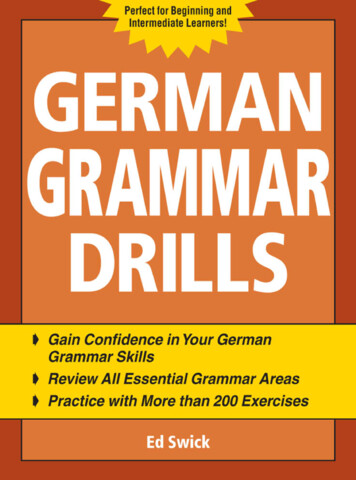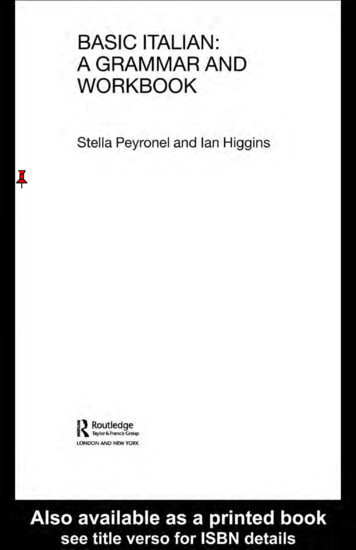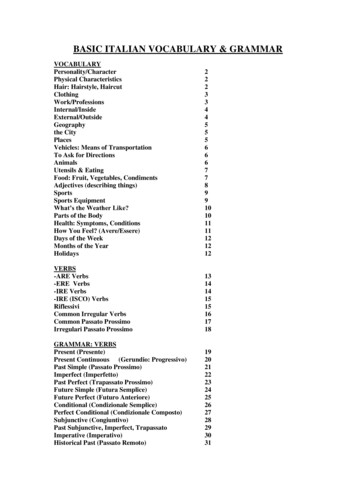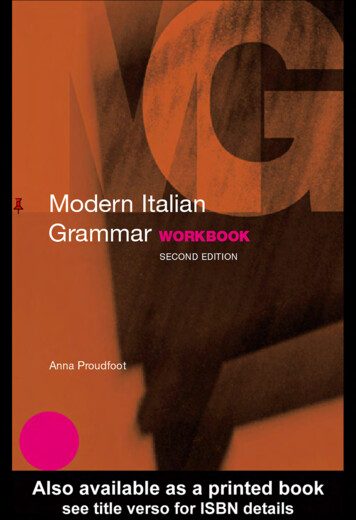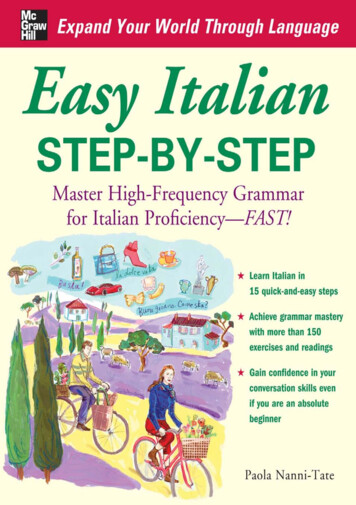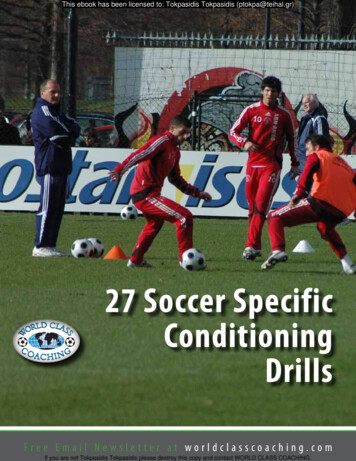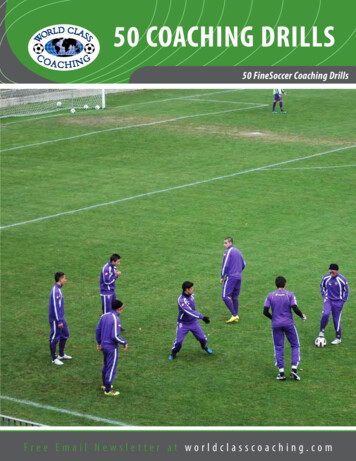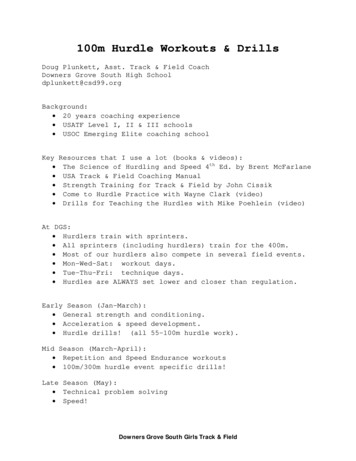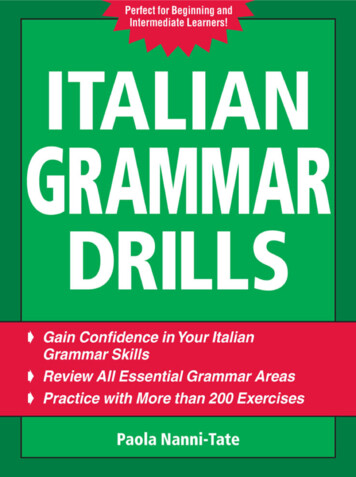
Transcription
ITALIANGRAMMARDRILLS
This page intentionally left blank
ITALIANGRAMMARDRILLSPaola Nanni-TateNew York Chicago San Francisco Lisbon London Madrid Mexico CityMilan New Delhi San Juan Seoul Singapore Sydney Toronto
Copyright 2007 by The McGraw-Hill Companies, Inc. All rights reserved. Manufactured in the United States of America. Except as permitted underthe United States Copyright Act of 1976, no part of this publication may be reproduced or distributed in any form or by any means, or stored in a database or retrieval system, without the prior written permission of the publisher.0-07-159357-8The material in this eBook also appears in the print version of this title: 0-07-147232-0.All trademarks are trademarks of their respective owners. Rather than put a trademark symbol after every occurrence of a trademarked name, we usenames in an editorial fashion only, and to the benefit of the trademark owner, with no intention of infringement of the trademark. Where suchdesignations appear in this book, they have been printed with initial caps.McGraw-Hill eBooks are available at special quantity discounts to use as premiums and sales promotions, or for use in corporate training programs.For more information, please contact George Hoare, Special Sales, at george hoare@mcgraw-hill.com or (212) 904-4069.TERMS OF USEThis is a copyrighted work and The McGraw-Hill Companies, Inc. (“McGraw-Hill”) and its licensors reserve all rights in and to the work. Use of thiswork is subject to these terms. Except as permitted under the Copyright Act of 1976 and the right to store and retrieve one copy of the work, you maynot decompile, disassemble, reverse engineer, reproduce, modify, create derivative works based upon, transmit, distribute, disseminate, sell, publishor sublicense the work or any part of it without McGraw-Hill’s prior consent. You may use the work for your own noncommercial and personal use;any other use of the work is strictly prohibited. Your right to use the work may be terminated if you fail to comply with these terms.THE WORK IS PROVIDED “AS IS.” McGRAW-HILL AND ITS LICENSORS MAKE NO GUARANTEES OR WARRANTIES AS TO THEACCURACY, ADEQUACY OR COMPLETENESS OF OR RESULTS TO BE OBTAINED FROM USING THE WORK, INCLUDING ANYINFORMATION THAT CAN BE ACCESSED THROUGH THE WORK VIA HYPERLINK OR OTHERWISE, AND EXPRESSLY DISCLAIMANY WARRANTY, EXPRESS OR IMPLIED, INCLUDING BUT NOT LIMITED TO IMPLIED WARRANTIES OF MERCHANTABILITY ORFITNESS FOR A PARTICULAR PURPOSE. McGraw-Hill and its licensors do not warrant or guarantee that the functions contained in the work willmeet your requirements or that its operation will be uninterrupted or error free. Neither McGraw-Hill nor its licensors shall be liable to you or anyoneelse for any inaccuracy, error or omission, regardless of cause, in the work or for any damages resulting therefrom. McGraw-Hill has noresponsibility for the content of any information accessed through the work. Under no circumstances shall McGraw-Hill and/or its licensors be liablefor any indirect, incidental, special, punitive, consequential or similar damages that result from the use of or inability to use the work, even if any ofthem has been advised of the possibility of such damages. This limitation of liability shall apply to any claim or cause whatsoever whether such claimor cause arises in contract, tort or otherwise.DOI: 10.1036/0071472320
ProfessionalWant to learn more?We hope you enjoy thisMcGraw-Hill eBook! Ifyou’d like more information about this book,its author, or related books and websites,please click here.
For more information about this title, click hereContentsPrefacevii1 Nouns12 Articles293 Pronouns494 Prepositions1015 Adjectives1396 Adverbs1717 Comparative and Superlative Forms ofAdjectives and Adverbs1858 Present Tense2019 The Imperative23510 Reflexive Verbs23911 Future Tense24512 Present Perfect Tense24913 Other Past Tenses25914 Conditional Tense281v
vi15 Subjunctive Mood29116 Passive Voice30917 Verbal Expressions, Idioms, andSpecial Constructions31518 Numbers, Time, and Dates33119 Exclamations347Answer Key351Contents
PrefaceIf you’ve picked up this book, you probably already know that to learn alanguage well—to have the ability to read it and write it and to understandothers in that language and be understood yourself—you must at some pointdeal with the grammar. Italian Grammar Drills will give you a better command of Italian grammar by providing plenty of writing drills that willreinforce your knowledge and enhance your ability to speak, read, and writewith finesse. You will be able to work at your own pace while focusing onthose aspects of grammar that you feel require most of your attention.Each of the book’s nineteen chapters features concise explanations ofvarious grammar topics. And each chapter includes a variety of exercises thatwill reinforce your ability to manipulate the Italian language and give youan opportunity to immediately apply what you have learned. You can findanswers to all exercises in the Answer Key at the back of this book. Whenusing this book, you can follow the order presented or skip a chapter andreturn to it at a later time.Once you’ve worked your way through Italian Grammar Drills, not onlywill you find yourself confidently on your way to fluency, but you will alsofind that this book will remain a unique resource any time you need toclarify or review essential grammatical concepts.Sometimes learning a new language may appear to be an insurmountableand tedious task, but the students who stay with it and master the grammar will find it a satisfactory and gratifying experience. How exciting to beable to communicate in Italian and appreciate the language of Italy and itspeople! My hope and intent in writing Italian Grammar Drills is to give youa basic tool for understanding, speaking, reading, and writing basic Italian,whether you are learning the language on your own or with an instructor.viiCopyright 2007 by The McGraw-Hill Companies, Inc. Click here for terms of use.
I am proud and excited to help students learn such a beautiful language.I will never tire of the excitement I feel when I see students wanting to learnItalian and then mastering it through study and practice. It has been my pleasure and privilege to have written Italian Grammar Drills. I wish to thankmy editor, Garret Lemoi, for his guidance and many useful suggestions; myhusband, Bob Tate, for proofreading the text; and the many students whoencouraged me to write a grammar book.viiiPreface
1NounsA noun is used in a sentence to refer to people, animals, and objects that can be real or imaginary.GenderAll nouns in Italian are either masculine or feminine, whether they refer to people, animals, or things.It is important to know the gender of a noun in order to accompany it with the right article—il, lo,or la (the) or uno or una (a)—and the right adjective (definite and indefinite articles are discussed indepth in Chapter 2 and adjectives in Chapter 5). The other words in a sentence that refer to the nounmust agree in gender and number with that noun.Italian makes it easy to learn the gender of a noun: The noun’s ending often reveals whether itis masculine or feminine. Most nouns ending in -o are masculine and most nouns ending in -a arefeminine.masculineil cieloil librol’uccelloil violinofemininela casala finestrala portala tazzaskybookbirdviolinhousewindowdoorcupThere are a few exceptions. Some nouns ending in -a are masculine such otNouns of Greek origin ending in -ma are also masculine. For example:il climail fantasmail panoramaclimateghostlandscape1Copyright 2007 by The McGraw-Hill Companies, Inc. Click here for terms of use.
il problemail programmaproblemprogramAnd some nouns ending in -o are feminine:l’autola fotola manola motola radiocarphotohandmotorcycleradioL’auto, la foto, and la moto are abbreviations of l’automobile, la fotografia, and la motocicletta.Nouns with the following endings are generally masculine: -ore and -toreil difensoreil dottoreil professorelo sciatoredefenderdoctorprofessorskier -ere and -iereil cameriereil corrierel’ingegnerewaitercourierengineer -ame and -aleil catrameil falegnameil temporaletarcarpenterstormNouns with the following endings are generally feminine: -ionela colazionel’opinione2Italian Grammar Drillsbreakfastopinion
la pensionela stazionepensionstation(Most of these nouns correspond with English words ending in -tion or -sion.) -udine and -iginel’abitudinel’originela solitudinehabitoriginlonelinessl’attricela copiatricela direttriceactresscopying machinefemale manager/director -ice -tà and stytruthvirtue(Most of these nouns correspond with English words ending in -ty and -th.) -ila crisila tisicrisistuberculosisExercise 1Translate the following nouns into Italian. Don’t worry about putting in the articles; just pay attentionto the endings.1. book2. flowerNouns3
3. window4. door5. house6. cup7. birdExercise 2Translate the following nouns into Italian. Don’t worry about putting in the articles; just pay attentionto the endings.1. planet2. climate3. ghost4. pope5. pilot6. landscape7. hand8. photo9. car10. radio11. professor12. doctorExercise 3Translate the following nouns into Italian. Don’t worry about putting in the articles; just pay attentionto the endings.1. breakfast2. station3. opinion4. pension5. habit4Italian Grammar Drills
6. origin7. actress8. city9. honesty10. youth11. truth12. crisisChange of genderSometimes changing the gender of a noun also changes its meaning. For otortosudden light, lacetextfault, rtawhalehouse, lheadcakeExercise 4Translate the following nouns into Italian. Don’t worry about putting in the articles, just pay attention to the endings.1. case2. home3. text4. headNouns5
5. place6. mail7. lace8. pizza9. fashion10. mint11. cake12. chin13. door14. neckMany nouns referring to people can be both masculine or feminine depending on whether theyrefer to a male or a female. However, the definite article preceding the noun (see Chapter 2) and theadjective following it (see Chapter 5) must be either masculine or feminine, depending on the genderof the noun they are referring to.l’artistail/la cantanteil/la collegail/la consorteil/la dirigenteil/la fisiatrail/la nipoteil/la pediatrail/la pianistail/la turistaartistsingercolleaguespousemanagerphysical therapistnephew, niecepediatricianpianisttouristSome nouns referring to animals, however, have only one form to indicate male or female. Forexample:la balenal’elefanteil falcoil giaguarola giraffail pesce6Italian Grammar Drillswhaleelephanthawkjaguargiraffefish
la ranala tartarugala tigreil topofrogturtletigermouseWhen one needs to distinguish whether an animal is male or female, the term maschio (male) orfemmina (female) is added. It looks like this: l’elefante femmina (female elephant), la giraffa maschio(male giraffe).Some nouns ending in -a can be used to refer either to males or females but are considered feminine nouns, such nvictimExercise 5Translate the following nouns into Italian, this time including the definite articles. (The letters inparentheses refer to masculine [m.] and feminine [f.].)1. tourist (m.)2. colleague (f.)3. nephew4. niece5. singer (m.)6. patient (f.)7. spouse (m.)8. elephant (m.)9. hawk10. turtle11. crowd12. victim13. physical therapistMany masculine nouns referring to people or to occupations and professions have a separatefeminine gender using an -a ending.Nouns7
masculineil cassiereil figlioil nonnoil parrucchiereil signorecashiersongrandfatherhair stylistgentlemanfemininela cassierala figliala nonnala parrucchierala signoracashierdaughtergrandmotherhair stylistladyOther masculine nouns add the suffix -essa in the feminine form.masculinel’avvocatoil dottoreil poetail ssala dottoressala poetessala principessafemale lawyerfemale doctorfemale poetprincessAnd some masculine nouns change the -tore ending to -trice in the feminine version.masculinel’attoreil direttoreil redattorelo ela direttricela redattricela sciatriceactressfemale directorfemale editorfemale skierSometimes the feminine forms are significantly modified from the masculine. These are usuallywords inherited from Latin.masculinel’abateil diol’eroeil galloil rehead priest, abbotgodheroroosterkingfemininela badessala deal’eroinala gallinala reginahead of a nunnerygoddessheroinechickenqueenA few nouns have completely different forms in the masculine and in the feminine.masculineil frateil fratelloil genero8Italian Grammar Drillsmonkbrotherson-in-lawfemininela suorala sorellala nuoranunsisterdaughter-in-law
il maritoil maschioil minamadredonnawifefemalemotherwomanExercise 6Translate the following nouns into Italian using the definite articles.1. son2. uncle3. daughter4. grandmother5. gentleman6. poet (m.)7. doctor (f.)8. actor (m.)9. skier (m.)10. skier (f.)There are other words in Italian that are always treated as masculine. The following list will helpyou get a feel for some of these nouns. Days of the week (except for la domenica, turdaySunday Months of the yeargennaiofebbraioJanuaryFebruaryNouns9
berOctoberNovemberDecember Names of metals and chemical elemen
Italian Grammar Drills will give you a better com-mand of Italian grammar by providing plenty of writing drills that will reinforce your knowledge and enhance your ability to speak, read, and write with finesse. You will be able to work at your own pace while focusing on those aspects of grammar that you feel require most of your attention. Each of the book’s nineteen chapters features .
